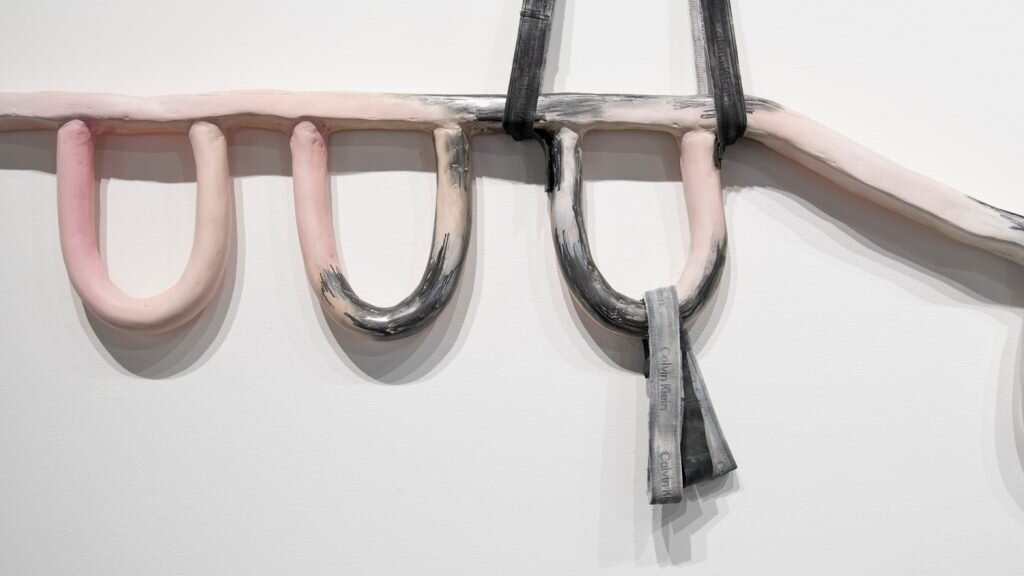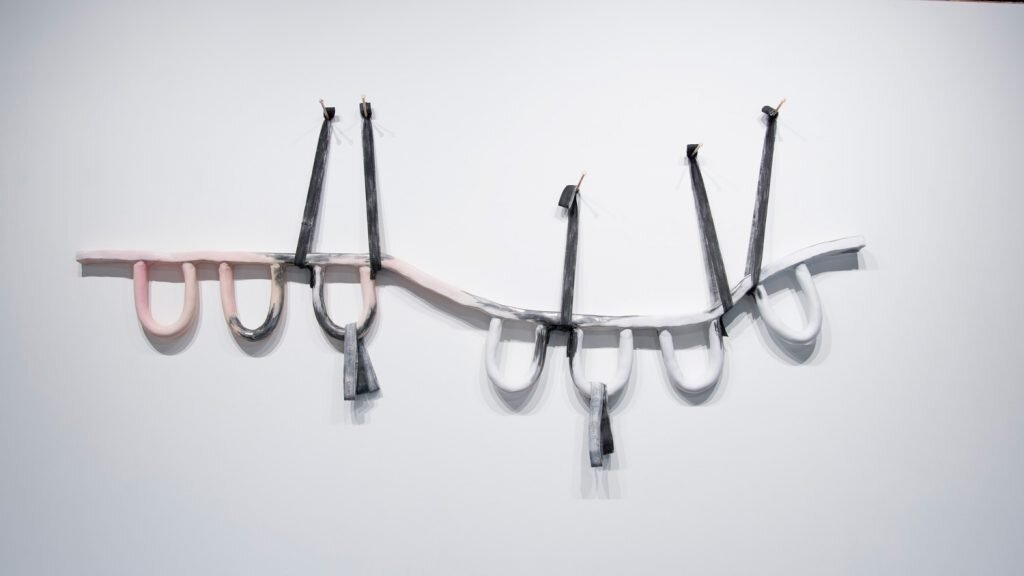“Benjamin Rosenthal: and the band played on, and on on,” | KC Studio Online Review
people will say, [they say] choose your tethers wisely (and the binds, bind-bind)
gouache and graphite on unfired clay with aqua-resin, nylon rope, gouache on steel nail with silicone // dimensions variable // 2020-21
As the Titanic plunged slowly into the ocean, the ship’s band continued to play, strumming over tragedy with familiarity. Benjamin Rosenthal’s solo exhibition at Studios Inc, “and the band played on, and on on,” is conceptualized around this tragedy and the HIV/AIDS film of the same title. It is a nod to the sinking ships our lives have become through this pandemic, especially those in the queer community. Though the word “queer” has morphed from a slur to a term of endearment, queerness still exists beyond normativity. Rosenthal teeters on a decidedly queer edge to present a show that is both solemn and playful; dangerous and funny; sexual and violent.
“and the band played on and on, on (people will say we’re in love)gouache and graphite on unfired clay with aqua-resin, acrylic and graphite on vinyl dry-bag, graphite on underwear elastic // 89″ X 28″ X 44″ // 2018-2021”
“and the band played on, and on on” is Rosenthal’s culminating exhibition at Studios Inc. He thought it was finally time to create a show around queer joy, but unfortunately, the times changed. Joy was replaced with dread as the COVID-19 pandemic tore through the globe. At the same time, Rosenthal mused, “I was struck by the rapidity with which we responded, particularly the response from the government. The global response was so dramatic compared to HIV/AIDS. I think that’s something queer people feel deeply.” Queer spaces, like bars and community centers, were shuttered. Chosen families were stunted, while nuclear ones were forced together. The resulting exhibition is much less joyous yet no less queer.
“all the king’s horses and all the king’s men; (((phantoms, they drifted)))
gouache and graphite on unfired clay with aqua-resin, graphite and gouache on underwear elastic, gouache on steel nails with silicone, rubber // 90″ X 40″ X 6″ // 2018-2021”
Rosenthal’s massive sculptures, which he calls objects, create continuity throughout the space. Gouache and graphite cover unfired clay with Aqua-Resin to form these objects. While they initially seem quite abstract, their humanity appears through the pink of interior flesh and the bumps, divots and imperfections of a life lived. Rosenthal also features four new graphite and sumi ink drawings of phalluses, not genitals — something queer yet not specifically gay. The show isn’t a quick hit of aesthetically pleasing art; instead, there is a disturbing pulse beating throughout that requires careful consideration.
and; they plunged, and unto (((the fields)))
graphite and sumi ink on paper // 30 1/4″ X 44″ // 2021
The flow of words and meticulous punctuation of Rosenthal’s titles add poetry to the visual pieces. “[they] know what boy’s like, but make it wanton (deeper(er)) — a black and white yoke held up by bands of Calvin Klein underwear — greets attendees at the entrance. The sculpture and the title taken together, illicit a feeling of queer sex and bondage. The extra “er” in “(deeper(er))” conjures the motions of penetrative sex. “portrait of a ghost[ed] image, (mirrored, breathless(ed))” is shaped similarly to the other body-like objects, yet it is void of the fleshy pink of life. It is ghostly white, “mirrored” in the sense that the object is the same height as Rosenthal, “breathless(ed))” as if this were something done to him. These fragmented, lyrical titles are nearly as moving as the pieces themselves. As such, they could be larger or otherwise incorporated into the exhibition to highlight their importance.
[they] know what boy’s like, but make it wanton (deeper(er))
gouache and graphite on unfired clay with aqua-resin, graphite on underwear elastic, gouache on steel nails with silicone // 26″ X 25″ X 6″ // 2018-2021
Everything in “and the band played on, and on on” is a methodical, intentional ode to queer humanity in a time fraught with desperation. Rosenthal has torn off the protective layers of acceptability to reveal the raw, pink interior of genuine life. It doesn’t fit neatly into a box, but rather sticks its foot out (both literally and figuratively) as if to trip the audience. Each piece is arranged with austerity and starkness. Genderless, abstract bodily objects stir internal commentaries about life, loss, sexuality, and aging. To achieve the full effect of such a multilayered concept, “and the band played on, and on on” could use some contextualizing. However, audiences will and should also draw their own conclusions.
to lay hands (people will say we were bound, by, and)
3D Animation // 1 minute 30 seconds (looped and installed) // 2021
Written by Emily Spradling for KC Studio Magazine
Read more about Benjamin Rosenthal on KC Studio here

![people will say, [they say] choose your tethers wisely (and the binds, bind-bind) gouache and graphite on unfired clay with aqua-resin, nylon rope, gouache on steel nail with silicone // dimensions variable // 2020-21](https://images.squarespace-cdn.com/content/v1/64b1b0aa9326bb5ba27a9034/1689367025608-N8YJ31AEGKR3O4AFR4CG/rosenthal7-1360x1083.jpg)






![[they] know what boy’s like, but make it wanton (deeper(er)) gouache and graphite on unfired clay with aqua-resin, graphite on underwear elastic, gouache on steel nails with silicone // 26″ X 25″ X 6″ // 2018-2021](https://images.squarespace-cdn.com/content/v1/64b1b0aa9326bb5ba27a9034/1689367025644-YG98VGPWPQGXXREC3EBV/rosenthal1-1024x699.jpg)
